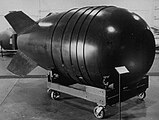Mark 6 nuclear bomb

The Mark 6 nuclear bomb was an American nuclear bomb based on the earlier Mark 4 nuclear bomb and its predecessor, the Mark 3 Fat Man nuclear bomb design.
The Mark 6 was in production from 1951 to 1955 and saw service until 1962. Seven variants and versions were produced, with a total production run of all models of 1100 bombs.
The basic Mark 6 design was 61 inches (150 cm) in diameter and 128 inches (330 cm) long, the same basic dimensions as the Mark 4. Various models of the Mark 6 were roughly 25% lighter than either the Mark 4 or Fat Man, and weighed 7,600 to 8,500 pounds (3,400–3,900 kg).
Early models of the Mark 6 used the same 32-point implosion system design concept as the earlier Mark 4 and Mark 3; the Mark 6 Mod 2 and later used a different, 60-point implosion system.
Various models and pit options gave nuclear yields of 18, 26, 80, 154, and 160 kilotons for Mark 6 models.
Survivors
[edit]There are several Mark 6 casings on display:
- Defense Nuclear Weapons School on Kirtland Air Force Base in Albuquerque, New Mexico
- Cold War Gallery of the National Museum of the United States Air Force in Dayton, Ohio
- Museum of Aviation (Warner Robins) in Warner Robins, Georgia
- Hill Aerospace Museum in Ogden, Utah
Variants
[edit]Mark 13
[edit]The Mark 13 nuclear bomb and W13 missile warhead were developed as higher-efficiency Mark 6 successors, the same size and basic configuration as the Mark 6 but utilizing an improved 92-point implosion system. The Mark 13 was cancelled in August 1954 and the W13 cancelled September 1954, in both cases without ever seeing production service.
Mark 18
[edit]The Mark 18 nuclear bomb was a follow-on to the Mark 6 and Mark 13, utilizing a fissile pit assembly with around 60 kilograms of HEU and delivering a yield of 500 kilotons, the largest pure-fission (non-thermonuclear) bomb design ever developed by the US. Mark 18 bombs were eventually recycled into Mark 6 Mod 6 bombs after thermonuclear weapons were deployed in quantity. The Mark 18 was tested once in Operation Ivy King.
XM1 Atomic Demolition Munition
[edit]An Atomic Demolition Munition, the XM1 was developed. Few details on the system exist.[1]
Gallery
[edit]-
The XM1 ADM that contained a Mark 6 nuclear warhead
See also
[edit]References
[edit]- ^ Glen George McDuff (2018-08-22). Army Nukes (Report). Los Alamos National Lab. p. 32. OSTI 1467305.
External links
[edit]- Allbombs.html list of all US nuclear warheads at nuclearweaponarchive.org
| Fission (including boosted) |
| ||||||||||
|---|---|---|---|---|---|---|---|---|---|---|---|
| Thermonuclear |
| ||||||||||
| Enhanced radiation |
| ||||||||||
| Primary stages | |||||||||||
| Experimental | |||||||||||
Text is available under the CC BY-SA 4.0 license; additional terms may apply.
Images, videos and audio are available under their respective licenses.





